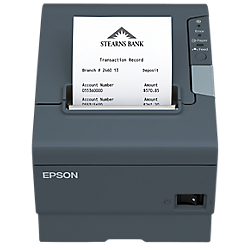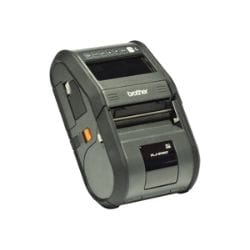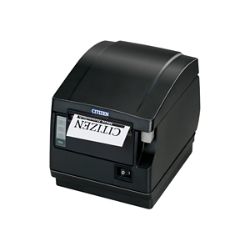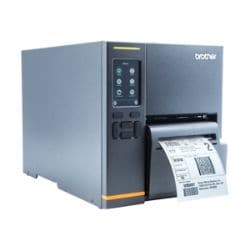March 14, 2022
What is a Thermal Printer and How Does it Work?
Read this guide to learn the pros and cons of thermal printers and everything you need to know when purchasing a thermal printer.
Thermal printers offer convenience in printing labels, receipts and bar codes quickly and cost effectively in a set location or on the go. In this post, we’ll walk you through everything you need to know about how a thermal printer works and the key features to look for so you can find the right model for your business.
What is a Thermal Printer?
A thermal printer is a type of printer that uses a heated thermal printhead pressed against a medium to produce black text or images. The heated printhead either activates special chemically treated paper (called thermal paper) or transfers solid ink from a ribbon and bonds it to the medium, depending on the type of thermal printer. They are commonly used in producing labels, receipts, barcodes, ID badges and many more applications across a vast number of industries.
How Does a Thermal Printer Work?
To understand how a thermal printer works, you first need to understand there are two types of thermal printing methods: thermal transfer printing and direct thermal printing.
Direct Thermal Printing
There is no ribbon, ink or toner involved with direct thermal printing. Instead, the printhead applies pressure and heat directly onto the surface of heat-sensitive thermal paper. The thermal paper reacts to the heat of the printhead, blackening when heated and producing an image or text.
Maintenance costs for direct thermal printers are low compared to other types of printers due to the fact no ink or toner is needed. One drawback, though, as mentioned above, is that your printed items may be prone to fading over time since thermal paper is particularly sensitive to heat and light. You may notice old receipts you have fade over time due to being printed on thermal paper. Additionally, you are only able to print in one color at a time when using this type of thermal printer, as the printing material itself is what determines the color.
Thermal Transfer Printing
Rather than printing directly onto the surface of the printing material like direct thermal printing, the printhead of thermal transfer printers presses a wax-coated ink ribbon (or ribbons) onto the surface of the printing material. The wax is melted, exposing the ink, which is transferred to the printing material and dries there.
The key advantage of this type of thermal printer compared to a direct thermal printer is that prints are less likely to fade over time, and you can print in multiple colors at once (assuming your printer has multiple ribbons). That said, with the introduction of the ribbon, which needs to be replaced, long-term maintenance costs can be greater. And with more moving parts, these printers may be slightly more prone to operational issues—though they are still reliable and durable.
What are Thermal Printers Used For?
Thermal printers are used in a vast number of applications since they are energy-efficient, fast and portable. Here are some uses among many across different industries:
- Logistics and Transportation: shipping, receiving, inventory management, packing slips, return labels
- Manufacturing: labels for compliance, maintenance or parts management, quality assurance, progress tracking
- Healthcare: patient identification wristbands, lab or pharmacy sample labels, asset management
- Retail and Hospitality: price tags, POS or mobile POS receipts, guest cards or passes, ID badges, inventory management
- Government: supply chain labels, emergency management, ID badges, system administration
Thermal Printer Pros and Cons
Trying to decide if a thermal printer is worth it for you versus the other types of printers out there? Assess these thermal printer pros and cons.
Thermal Printer Pros
Here are some advantages of thermal printers to consider:
Thermal printers keep costs low as they do not rely on ink to print.
No ribbons, cartridges or other supplies need to be replaced to ensure continued use. The media alone is the only supply required to keep the printer running.
These compact printers are portable and convenient to use on the go.
A lightweight design makes them easy to take with you anywhere. Use them in the office or warehouse, at tradeshows and on demos.
Thermal printers offer quality results with high printing speeds.
Expect smudge-free results that tend to be highly legible and long lasting, and take milliseconds to print.
Thermal printers have few moving parts.
Since thermal printers have few moving parts, less things break and they are easy to maintain. Thermal printer printheads last about 10 years on average.
Thermal Printer Cons
Here's what you should know about the negative side of thermal printers:
Thermal-printed labels may fade over time.
Direct sun exposure and heat can speed up this process, and even labels identifying boxes kept in storage may begin to fade over the years. Thermal paper must be stored at room temperature to last.
Thermal-printed labels may turn fully black when exposed to high heat.
This may cause you to lose important data or records if you haven't saved the information elsewhere. It's best if labels are kept at room temperature and not exposed to any heat, moisture or sunlight.
Direct thermal printing uses only one color at a time.
Black printing tends to be the most common, while other colors like red may be available when buying replacement labels or paper. Thermal transfer printers allow for more colors and different print media.
Thermal printers cost more than your average inkjet printer.
Thermal printers average about $300-400 USD but industrial thermal printers can get into the thousands. Also their specialized parts are expensive to replace and the printhead can be damaged due to excess heat.
Selecting Your Thermal Printer by Model
Once you decide on the type of thermal printer you need, there are several different models to choose from — size is the primary differentiator here. When you know your printer's primary task, you can choose a thermal printer that meets and exceeds those needs.
Mobile Thermal Printers
Mobile thermal printers are handheld models meant to be portable and wireless. Good mobile printers have easy-to-install software and should be able to print a variety of labels or receipts on the go. They are often meant for rough field environments or warehouses and have some level of durability. Some are even waterproof or temperature resistant.
Choose this if you don't have time to print from a central location or need a sturdy but lightweight unit.
Desktop Thermal Printers
Desktop printers are slightly larger than their handheld counterparts but shouldn't take up too much of a footprint on a desk. These printers often come with wired or wireless connections and can handle a decent volume of label or receipt printing in a retail environment.
Choose this if you want a reliable, cost-effective printer that needs minimal maintenance.
Industrial Thermal Printers
If you know you'll be printing at a high volume, industrial printers will get the job done. Typically larger in size and ruggedized, industrial printers should be able to handle 24/7 print jobs like those needed for logistics or manufacturing. Top of the line models might even be equipped with Internet of Things (IoT) software for easier control.
Choose this if you're running a huge operation with a need to print constantly and reliably.
Difference Between Inkjet and Thermal Printers
Here's a few points to consider when comparing inkjet vs. thermal printers:
Inkjet Printers
- Print Method: Spray ink out of a nozzle onto paper/substrate in tiny droplets
- Costs: Lower upfront cost vs. thermal printers and wide availability of print supplies/parts
- Print Quality: Most inkjets are capable of producing lifelike images. Prints can be degraded under exposure to moisture and sunlight
- Durability: More moving parts = more likely to break down, spray nozzles can get clogged
- Portability: Not very portable generally, limited to home and office environment
- Power: Typically require AC power, not as energy-efficient as thermal printers
- Use Cases: Best for basic home/office printing, photos, flyers, manuals and temporary signage
Thermal Printers
- Print Method: No ink or toner used in print process, either press waxy pigment onto paper or use heated printhead to print
- Costs: More costly than the average inkjet upfront, replacement parts are harder to find and more costly
- Print Quality: Limited in what colors you can print, but you get consistent and precise print quality. Prints tend to hold up better over time, as long as not exposed to excessive heat and light
- Durability: Few moving parts = less likely to break down. The printhead will last around 10 years
- Portability: Plenty of mobile form factors to choose from, like handheld or wearable devices
- Power: AC and battery powered units
- Use Cases: Best for signs, labels, barcodes and receipt printing
Are Thermal Printers Worth It?
If you're looking for a good, sustainable solution for printing signs, shipping labels, barcodes or receipts, thermal printers are an excellent choice. Inkjets, while capable of producing photorealistic prints, have a lot of restraints in terms of portability and consumable costs that make them a less-than-ideal option for these applications. While you may pay more up front, you'll eventually save on the cost of consumables and from the overall durability of thermal printers.
Shop Thermal Printers
We hope this guide on how thermal printers work can help you to select the model that is best suited for your business needs. Take some time to research the features and browse through some thermal printer reviews as you choose a printer that will deliver convenience, speed and quality results.




